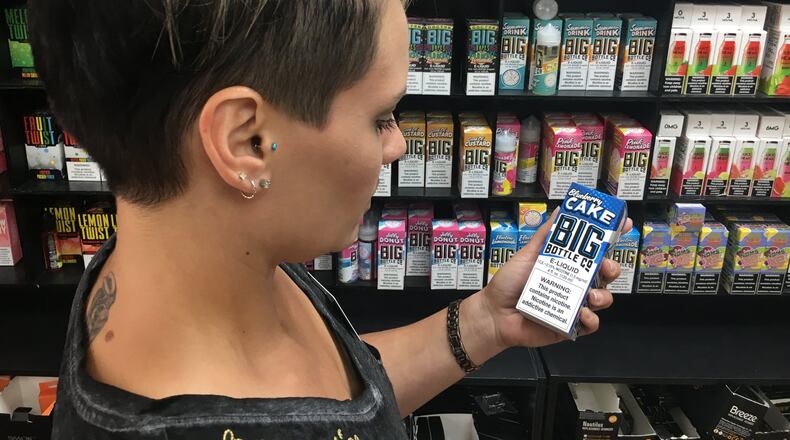The move comes just days after Ohio Gov. Mike DeWine, who has made child protection a hallmark of his career, announced he is researching whether he has the legal authority to ban liquid flavors used in e-cigarettes as one way to battle against children vaping.
The rise in e-cigarette use by school age teens is “a severe public health issue that needs to be addressed,” said DeWine spokesman Dan Tierney.
DeWine and Ohio Department of Health Director Dr. Amy Acton have been working on the issue, Tierney said.
“The explosive increase in vaping among our youth is a public health crisis, and we must educate them and their parents about the dangers of vaping,” Acton said. “Youth have shown an increased vulnerability to nicotine addiction, and evidence suggests that nicotine use during adolescence and young adulthood has long-term impacts on brain development.”
If Ohio bans flavored vaping products, it will all but wipe out the state's 650-plus vaping stores, James Jarvis, president of the Ohio Vapor Trade Association, a vaping industry trade group, told Cleveland.com. The flavored e-liquids are essentially the entire inventory of a vapor store, said Chris Voudris, co-owner of the local Vapor Haus chain.
“The flavor ban would destroy thousands of jobs in Ohio; it would destroy the whole industry,” Voudris said. “It actually creates a much bigger problem and epidemic because people are going to go back to cigarettes.”
Michigan Gov. Gretchen Whitmer and New York Gov. Andrew Cuomo recently each issued executive orders to ban the sale of flavored e-cigarettes. The Trump administration is also exploring plans to ban flavored e-cigarettes, excluding tobacco flavors.
»Related: Ohio to spend $4.1 million on programs aimed to fight youth vaping
E-cigarette flavor liquids available online include bubblegum, root beer, cotton candy, cookies and other flavors that critics say appeal particularly to children.
“I’ve been smoking since I was 16, 17. I will be 48 on Saturday and I quit 13 months ago. I was still smoking a couple cigarettes a day when I came in here,” said Kathy VanEiszner of Kettering, who was shopping at the Vapor Haus store on Marshall Road Wednesday. “If (e-liquids) tasted like tobacco, I don’t know if I would have stopped smoking completely.”
VanEiszner on Wednesday decreased the amount of nicotine in her flavored e-liquid, taking steps toward weaning off nicotine entirely. Advocates of vaping, including Voudris, said banning all flavors would prevent people like Van Eiszner from being able to quit and could force many in the process back to cigarettes. They could also easily move their business to Indiana or Kentucky, or random online businesses where the ban wouldn’t apply, Voudris said..
Included in DeWine’s two-year state budget bill is a new law that bumps the tobacco and vaping product purchase age to 21 as of next month.
The number of Ohio teens who smoke cigarettes has declined dramatically over the last 20 years, and public health officials are worried that the rise in vaping is undoing their hard work. Nationally, last year there was a 48 percent rise in vaping among middle schoolers and a 78 percent increase in vaping among high schoolers.
»FDA: E-cigarette epidemic among teenagers needs solution
The federal Food and Drug Administration data show 3.62 million U.S. middle and high school students are using e-cigarettes, including 21 percent of high school students in 2018, up from 11.7 percent in 2017.
Public health officials are also alarmed by reports of a severe pulmonary illness linked to vaping. So far, the CDC says there are more than 450 possible cases across 33 states. Ten cases have been confirmed in Ohio.
The Ohio Vapor Trade Association said recently that it supports efforts to educate youth about vaping. But the trade group urged caution against blaming the pulmonary illnesses solely on vaping liquid nicotine products until all the investigations are concluded. Some cases are linked to vaping of THC products purchased on the black market, the association noted.
»RELATED: FDA, local schools take steps as teen e-cigarette use surges
“If you take away the one way that you can essentially monitor the industry, with the brick-and-mortar, all you’re going to do is create a black market and that’s the most dangerous side of it,” Voudris said. “You’re going to have people mixing this stuff in an inappropriate way. The bottles that we sell, the liquids we sell, they’re all made in really highly certified labs…People would be making it in their basement or buying it off random websites or ebay.”
Other regulations could also go by the wayside in the black market mixes, Voudris said, including proper labeling showing levels of nicotine and warnings along with child-proof caps. Vapor stores have been adamant that they are not where teens are getting the e-cigarettes and flavored liquids, blaming online sales and convenience stores.
“Vapor Haus and every other vape shop is an adult-only establishment,” Voudris said. “We do not sell to kids. Never have and never will.”
Staff writer Kaitlin Schroeder contributed to this report.
FIVE FAST READS
• Starbucks set to open largest coffee store, roastery in November
• Kroger launches own line of meatless burgers, plant-based foods
• Popular video game store closing up to 200 locations
• Kroger, Walmart asks shoppers not to openly carry guns, will allow concealed ones
• Target kicks off holiday hiring spree, looking for 130K workers


